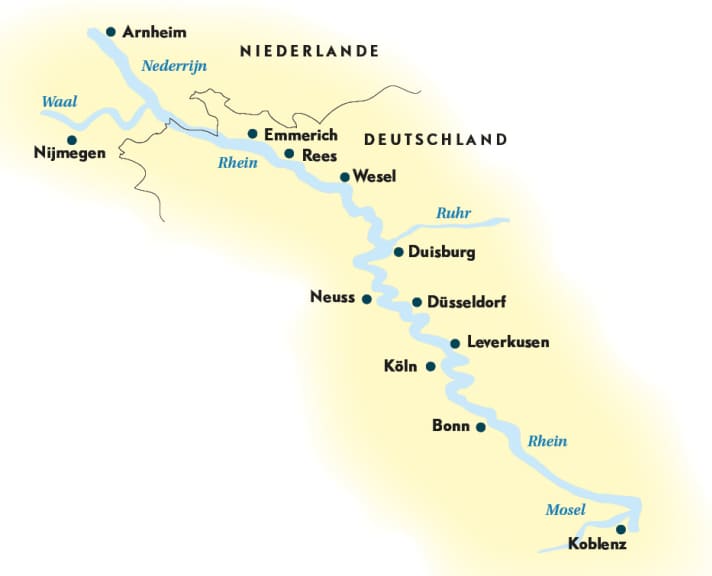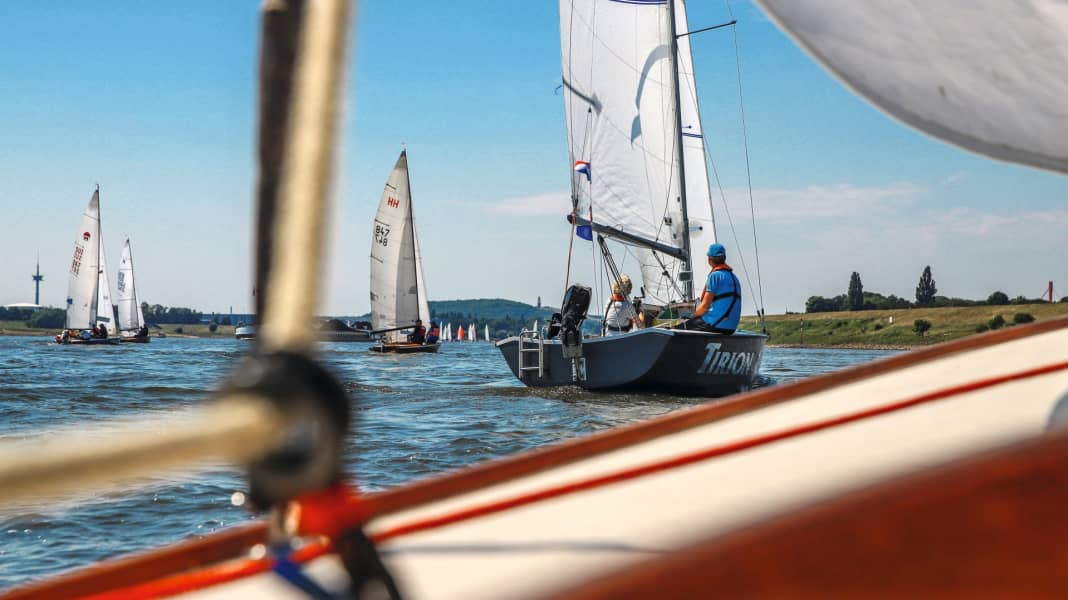
Whitsun Saturday, the sun is shining, a moderate sailing wind is blowing. The best jumper-and-shorts weather. Only occasionally does the "Li" heel so much that her lee bow takes on water and the bilge pump gurgles. The L-boat, an open three-man keelboat, was built by Abeking & Rasmussen in 1949: a classically elegant regatta boat, also an afternoon boat, as it used to be called, with an elongated hull, long overhangs, low freeboard and a high rig. The "Li" perfectly combines what the Rhine Week stands for: fun and excitement, cruising and regatta action.
We whizz along carefree, kilometre after kilometre, from the railway port in Duisburg to Wesel, for two and a half hours. Past the sandy, tree-lined banks of the Lower Rhine, past towns, cooling towers and cranes, past countless industrial backdrops.
It is not least these scenic contrasts that make up a large part of the appeal of sailing on the Rhine. Even if "Li" foreskipper Kim Mikkelsen emphasises that he wouldn't want to have a ship moored here. "But the Rhine Week is really fun!" he says.
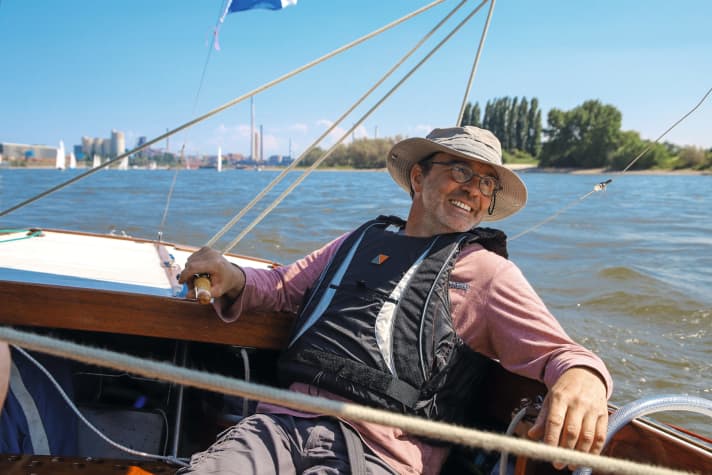
The Rhine Week is the oldest, largest and longest river regatta, at least in Europe. It turned one hundred years old this year. The route changes every year; in 1922, for example, it went from Andernach to Emmerich. That is more than two hundred kilometres; 52 sailing boats took part at the time. People have been racing on the river since the end of the last century: the Cologne Yacht Club, for example, was founded on the Kaiser's birthday in 1900, when tugs with smoking steam engines still dominated the river and even larger sailing yachts did not have an auxiliary engine. Where sailing was no longer enough, people had to paddle.
This is still the case today, except that a motorboat is now on hand if the wind runs out. However, incidents such as the one from the 1920s, which can be found in an old programme, are history: "The start became disorderly due to barrels of Moselle wine drifting past from a sunken barge, as all the sailors were busy fishing them up." The boat with the most wine on board was crowned the winner without further ado, according to the chronicle.
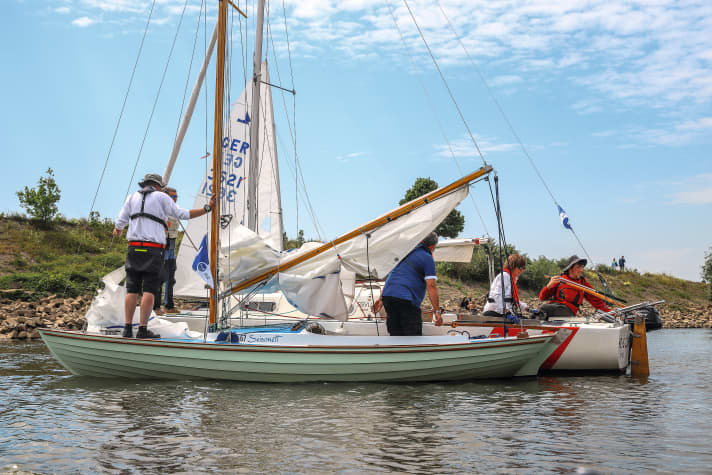
Since those days, the Rhine has become narrower, the current stronger, steamers have disappeared, most ferries have been replaced by bridges and numerous bays and oxbow lakes have silted up. Today, the picture is dominated by container ships, tankers and river cruisers loaded to the rafters, as well as general cargo freighters and tug and tow convoys 240 metres long. They all have right of way. And they all have a blind spot that can be up to 500 metres long. It can take two minutes for a sailor to be seen from the bridge.
Avoiding commercial vessels is not just a question of safety or traffic regulations. It also has tactical advantages. For one thing, you should not get caught in their slipstream. Above all, however, the propeller water of those travelling against the current can be used for turning or for an extra push. On the other hand, you should avoid the propeller water of those travelling downstream. There is a danger here due to the suction effect.
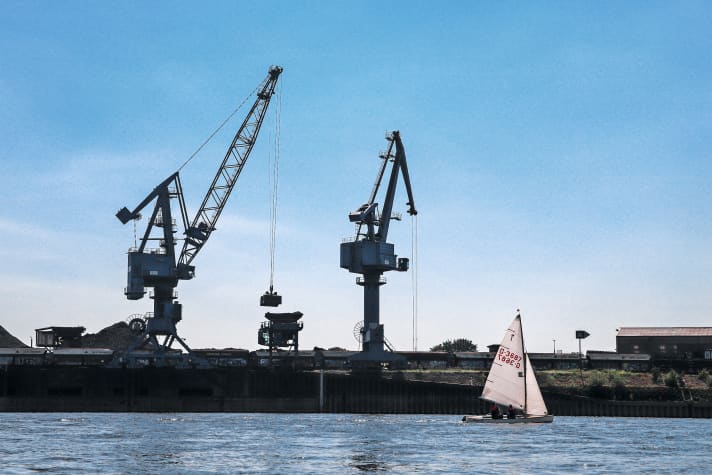
The Rhine Week is always sailed downstream. The river then pushes the ships towards their destination at an additional speed of four to eight kilometres per hour. This is why sailing is even possible in calm conditions - the old Rhine sailors call this art "stiwweln". The aim is to convert the speed of the current into speed and then into wind. Because there is no regatta triangle and no up-and-down course, but simply a stretch downstream, the start is very different from the usual start of a race. As they set off from Düsseldorf in the direction of Duisburg, many sailors remain in the narrow, shallow harbour basin for a long time, jostling close together where there is hardly any current. Under no circumstances do you want to drift too close to the starting line too early. Then you'll be over it before you know it. The rule of thumb is: five minutes before the start, you can still be 500 metres from the start line on the Rhine.
Small cruisers and dinghies dominate the field of participants, high-bred regatta racers are rarely seen and foil sails are rare. Instead, many families, parents with children and sailors who don't fight for every metre with a knife between their teeth have always attended. The Rhine Week is more of a shared outing than a tough competition.
Several groups will start, the fastest first and those with a yardstick of over 110 last. Anyone with a maximum yardstick of 118 is allowed to take part - otherwise the field will spread out too much, and there are supposed to be two races each day. Even so, there can easily be ten river kilometres between the first and last in the field.
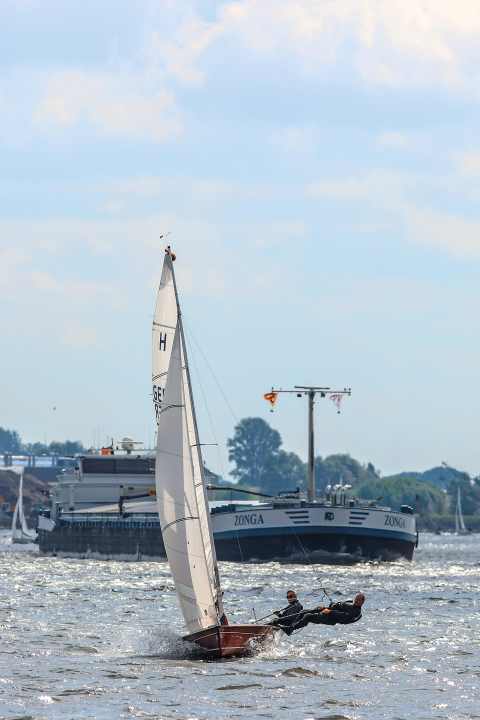
A total of 68 boats were entered this year, including seven Shark 24s, five H-boats, Sailhorses and Dyas and three J 22s. One boat, the "Madison", a Monas, even travelled all the way down the Rhine from Basel with a crew of four. The open keelboat is actually a single-handed boat with a self-tacking jib. After the week on the Rhine, the "Madison" travelled all the way to Amsterdam.
Peter Jonas, however, had to give up on the first leg of the Rhine Week, between Cologne and Düsseldorf. He had started the race as the foresailor of an RS Vision; it was the smallest boat in the regatta this year. But the dinghy capsized, the mast dug into the gravel and the DLRG had to rescue him and his skipper, who was also a bit older. They then gave up.
"I'm not taking any more risks," says the 67-year-old, who is now standing on the upper deck of the "Eureka", which always accompanies the competition - as a floating regatta office, as a place to sleep and eat, but also as a party boat. "I take my hat off to these two gentlemen," head of organisation Bernd Deertz will say later at the award ceremony - and that he personally "would not have chosen this boat for the Rhine Week". On the other hand, classic Lasers have also sailed the Rhine Week.

49 boats were entered in this year's competition for the "Blue Riband". This meant that the Rhine Week was unable to match the success of previous years, when up to 140 crews took part. But in the last two years, the volunteer-organised event was cancelled entirely due to the coronavirus pandemic. Before that, in 2019, six Beaufort winds prevailed, with gusts of up to nine! The start was "at your own risk", says Helge von der Linden. As co-organiser, he had hoped for a hundred starters, as the whole thing has to be financially viable. But smaller fields also have advantages, say the sailors: it is less stressful everywhere - in the harbours, at the crane, at lunch and when spending the night on the "Eureka".
The fact that the passenger ship now accompanies the regatta sailors is a gain in comfort. In the past, crews used to spend the night ashore in gymnasiums and barns if their own boat was too small. They were catered for from goulash cannons. Now the dormitory is located on the first deck of the "Eureka", where air mattresses and sleeping mats lie close together. The only drawback: there are no showers on board. But every day there is breakfast and lunch between two races.
Up on the bridge, Edwin Bosma, who used to drive tankers, is in command. He is a mixture of captain and emcee and creates a great atmosphere. Always travelling up and down the Rhine on the tanker was a bit boring, he says. "Now we're where the party is!" He says of his fellow professional skippers: "Most of them think that sailors don't belong on the Rhine." He thinks differently, the Rhine Week is "like a family" for him.

The tasks are divided up in this family. One person steers the support boat, others take care of the regatta, and still others ensure that everything runs smoothly on land. Katja Polzenberg, the chairwoman of the regatta community that organises all of this, for example, drives crews from A to B in her car for hours so that all of the trailers, cars and sailors are together in the same place at the end.
The "Li", for example, the oldest ship in the field, is normally moored on Lake Baldeney in Essen. Right at the beginning of the Rhine Week, she suffered a little, a pütting - the wood was already a little rotten - was torn out. The mast is now not quite as sturdy as it should be. "The genoa therefore has to stay in, the spinnaker can only go out when it's not blowing too hard," says skipper Marcel Teriete. He is a boat builder from Bremerhaven and brother of the owner Jürgen Teriete; together they have already completely refurbished the ship once. "'Li' is headstrong, stubborn and beautiful," says Marcel Teriete and calls her "a diva". On the first day, she ran aground near a groyne and the owner had to get into the river in his underwear to free the ship.
In Wesel, a singer performs in the evening, singing songs by Hans Albers next to the beer stand, after which a cover band takes over, imitating hits from days gone by. A few people dance to it, it's a bit like a town festival. As the sun sets, it bathes the sky in dazzling red-orange-pink light. Helge von der Linden, a specialist in paints, varnishes and resins in his main job and chairman of the Wesel Yacht Club as a sideline, will still be out and about by then. He keeps night watch on the "Eureka". During the day, he has to answer technical questions, help sailors who need tools and shake hands with mayors along the way who want to say a word of welcome. He also coordinates the DLRG, water police and regatta organisers. There is no time for sailing, although von der Linden has often travelled on the Rhine Week. Instead, his Blackbird "Fritz" is now leading the race, a slim, sporty dinghy with a lifting keel that his company once built at a trade fair.
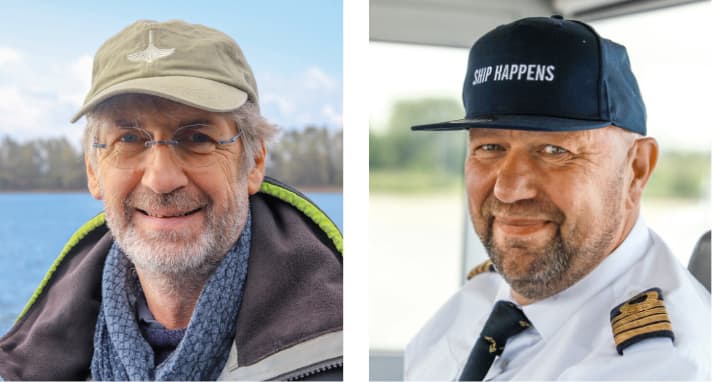
The next morning, the route continues 20 kilometres from Wesel to Rees. Thunderstorms threaten in the afternoon. One race is cancelled, so we have to sail longer on the last day: Past Emmerich to Arnhem, a distance of over 40 kilometres.
For the stage to Rees, we hire the Varianta VA 18 "St. George". Skipper Jochen Kiel, an engineer from the automotive industry, has been taking part in the Rhine Week since the mid-nineties, sometimes with a Dyas, a Kielzugvogel or a Shark 24. Cows moo on the banks while we complete the stage within one and a quarter hours. Since leaving the industrial backdrop of Duisburg, the Rhine is now very green on both sides. In the bends, you have to deviate from the shortest route and look for the path to the centre of the river, i.e. sail longer to make faster progress. At the end of the regatta, the "St George" will be in 34th place. "We're happy with that," says Jochen Kiel. "What counts for us is the fun of the event, the great route and meeting so many nice people."
Skipper Katrin and foresailor Jens Priewe achieve an unchallenged victory on their H dinghy "Tekitisi": they need just under 15 hours to complete the 185 kilometres of racing - and are delighted to receive the "Blue Riband". The three-man crew of the J 22 "7Sitzer" won the race.
Nevertheless, there are still one or two second finishes at the finish line in Arnhem. "You have to watch that," says Helge von der Linden. And grins with satisfaction.
